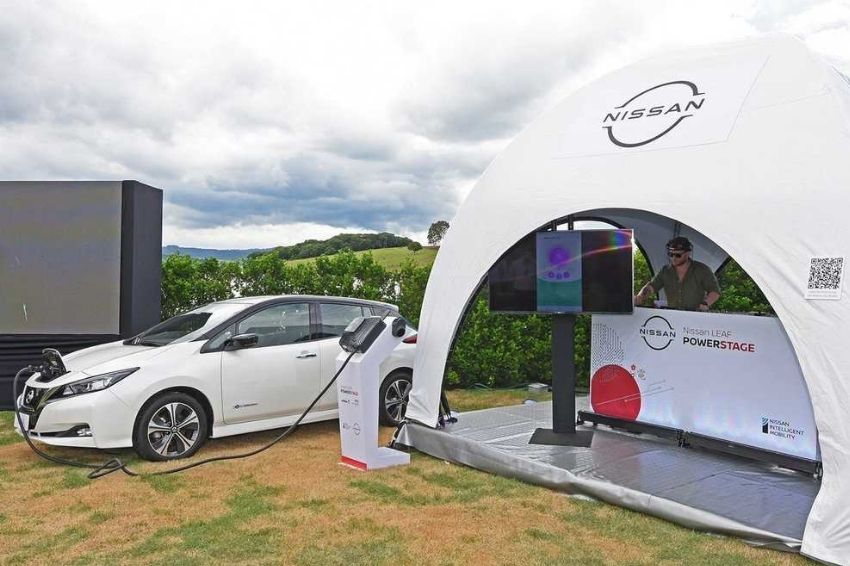Nissan displayed the 7.4 kW Wallbox Quasar during the Electric Experience, an event dedicated to electric mobility.
The bidirectional charger with V2G (Vehicle To Grid) technology, provided by Electric Mobility Brasil, makes it possible to charge an electric vehicle and send the energy stored in the car to the grid or electrical devices.
To demonstrate the operation of the bidirectional charger, the Nissan Leaf was used – the only vehicle sold by the automaker in Brazil that allows the use of this type of charger.
During the demonstration, the vehicle supplied energy to DJ Bruno Martini's soundboard. (See video below).
Eduardo José de Sousa, CEO of Electric Mobility, emphasizes that the main advantage of the V2G charger is supplying energy peaks.
“During the night, energy consumption drops a lot, but there is an energy peak during the afternoon, where we have industries, air conditioning, offices working and this creates a large energy peak. The electric car could be the solution to supply energy during this peak. In other words, the electric vehicle is charged during the day and then makes the stored energy available for household electricity consumption at night, supplying this peak.”
He also highlights other benefits that technology brings to the electricity sector. “I say that the big advantage is to alleviate large investments in infrastructure, in generation in power plants, water plants, transmission lines, distribution lines. In other words, you will avoid these future costs in energy infrastructure. It could even become a business for those who buy a car, as there are now studies for consumers to sell the energy generated at home. Then, you can charge the car overnight, that is, you buy energy during the night, and during the afternoon you can sell this energy”, he adds.
Asked whether the equipment can be used to send energy stored in the car to the grid, Sousa explains that this topic is already being discussed by ANEEL (National Electric Energy Agency). “Today there are already some discussion panels on how this integration will work. ANEEL is already analyzing this new technology, V2G, and is gathering information to define what the rules will be and how it should work”, he says.
The bidirectional equipment that Electric Mobility Brasil installed at the event for Nissan is manufactured by Wallbox. The company has already sold more than 66 thousand electric chargers worldwide from January to September 2021 and expects to close the year with global revenues of around USD $79 million. In Brazil, Electric Mobility Brasil will be the official representative in the country of the charger manufacturer.
How V2G technology works
V2G is a bi-directional charging technology, which can transform an electric vehicle into a battery on wheels, allowing an electric car to be charged and return the energy stored in the vehicle back to the electrical grid if necessary. The technique was pioneered in Japan.
The bidirectional charger can be programmed to behave like a power source connected in parallel to the grid, just as on-grid solar inverters do. The system's power injection is controlled through apps or through the car's own interface. This way, it is possible to program how much power the user wants their vehicle to discharge onto the network, or even preferred charging and discharging times. The example shown in the report reaches up to 7.4 kW of discharge power and can be controlled by cell phone or directly by the vehicle.
“We can see V2G as a battery system just like those used in hybrid or off-grid solar solutions, that is, with the help of sensors and the vehicle's own bidirectional charger, we can implement backup solutions when there is a power outage. on the public network, or even as a means of providing relief on the bills of customers who pay higher hourly rates during the peak period”, explains electrical engineer Mateus Vinturini.
“The possibility of using your vehicle as a battery in these scenarios further increases the importance of understanding hybrid systems and how we can benefit from them. Without a doubt, V2G is a disruptive technology that should change the way we understand the role of electric vehicles and energy storage in general”, he concludes.


















One Response
The possibilities of the energy market for the years to come are incredible. I've been a prosumer for a year and since then I've been reading a lot about this world. I hope that our country establishes policies that continue to favor investments by Individuals and Legal Entities in energy advancement and sustainability.